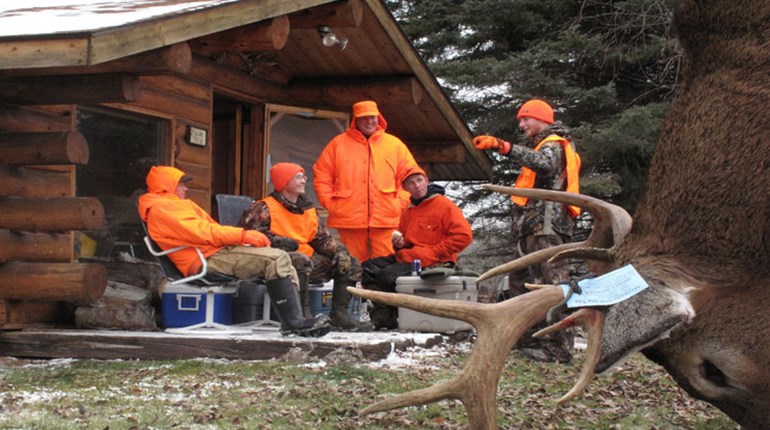So I’m on this ride-along with Sheriff Mike Lewis in Wicomico County, Md., for an article on guns and crime when he cuts the wheel and sends his black SUV throwing gravel down a long driveway. Before I can ask what’s up he says, “You’ve gotta meet the guy who lives here.” Now Sheriff Lewis is this straight-talking, Model 1911-wearing, Second Amendment-preaching cop whose graying hair is buzzed to stubs beneath a Stetson worn drill-sergeant fashion. In March of 2013 he traveled to Annapolis to publicly testify that the Maryland governor’s then-proposed gun-control law would “only harm law-abiding citizens.” Yeah, he’s the kind of cop we love in the movies but never think really exists. So I think, I’d like to meet a man who can impress this sheriff.
Sheriff Lewis stops his SUV suddenly on the long driveway and rolls down his tinted cop window. He points to a dozen bald eagles feeding in an open field. “That’s where Gene dumps the remains of his kills,” Mike says.
“So who is this guy?”
Sheriff Lewis has this “you’ll see” expression as he drives us another 50 yards and stops outside a metal barn. Through an open door we see a lean, white-haired man wearing a butcher’s stained rubber slicker and gloves. The guy stops skinning a fox and smiles at us.
As we get out of the SUV Sheriff Lewis says, “Meet Gene Garrett. Greatest trapper I’ve ever met.”
We step out and the first thing Gene says is, “I only caught five red foxes this morning. I’m off pace. Last season I trapped 490 foxes.”
I’m speechless. I notice 50 pelts drying behind Gene. I glance at the flat farm fields, houses and leafless trees all around. Like much of America between the cities, the country in southern Maryland is a patchwork of farm fields and woodlots. It’s cut by blue-gray asphalt roads and dotted with red barns, grain silos and single-family homes. Towns break up the pattern. They’re mostly small and have little Mayberry downtowns. Most of the traffic zooming through this country is going east on Route 50 to Ocean City, west to the Chesapeake Bay Bridge and Washington, D.C., or up or down the coast on Route 13. I look back to Gene and realize that as people travel through this land between metropolitan areas they’d never imagine that someone could trap 490 foxes from these little woodlots in one season.
The Life of a Trapper
Gene got his start trapping almost 50 years ago. He’d gotten out of the Army and a guy he met at work offered to show him how to trap. He began slow and didn’t get real serious until he retired. Now trapping is his life. From November into late winter he drives 100 miles per day to check his 100 or so traps. When he can, he checks them with a binocular. When he has to check a trap on foot he wears rubber boots and moves fast. He goes fast because every moment he’s there he’s potentially leaving human odor. Once or twice a year, he sells the skins to a fur buyer who trucks them to be sold at auction in Canada.
As he skins a fox I ask, “How long does it take you to skin a fox?”
“Seven minutes,” he replies. “It used to take me 30. The less time I’m skinning the more time I have to trap, so I’ve perfected my method.” Then he adds, “Fox are a challenge. I like out-thinking them. I like being out there every day.”
He explains that he caught what he calls a “digger” this morning. Some foxes get wise to traps. They carefully sniff around as they approach bait. When such a fox finds a trap it digs it up. He caught one this morning that had been digging up his traps for weeks. Gene looked at the terrain and figured the fox must be using a hole in the brush to pop out of a nearby ditch. He put a wire snare there and caught the fox.
He says he has learned to think like a fox. “The first thing that strikes your eye in a field will also attract the curiosity of a fox,” he says. “You start there with bait and traps. Then you dissect the field and think where they’re most likely to walk—ditches and trails and things. Then you set traps. I like double sets. Fox begin breeding in December, so if you set the traps right you can catch pairs.”
Gene gets access to a lot of property because he also nuisance-traps. All these landowners living in this land between metropolitan areas sooner or later have trouble with a raccoon, a skunk, a coyote or a fox. He says there have also been rabies outbreaks in the area. This scares people. To deal with these issues people call Gene. When he takes care of the problem he tells the property owner that he’d be happy to manage the populations of fox, raccoon and more on their land free if he can do it in the trapping season when he can get prime pelts.
The Rise of the Suburban Trapper
Gene is actually trendy in a counter-culture sort of way. Fur prices are generally rising again. Gene thinks maybe this is why trapping classes in his area have been filling to capacity.
“Friends who give trapping classes—mandatory courses needed to get a trapping license—tell me their classes are always packed,” he says. “A lot of people are interested. Next week I’m taking a few youngsters out to show them how to trap. I should pass this on. I’m 70 now so I only have 20 or 30 years left doing this.” He pauses, grinning: “I’ll do this until I can’t walk anymore.”
Mark Schaefer, president of the Rockland County Trappers Association in New York, parrots what Gene says.
“My classes are always to capacity,” he says. This astounds me, as people commute from Rockland County to nearby New York City and northern New Jersey. “Furbearers like the edge habitat and riparian areas running between housing developments,” says Mark. “Sometimes we get opposition from animal-rights activists, but when a homeowner has a raccoon move into their attic or beavers flooding their back yard they see the benefits of trapping and call one of our members.”
So from suburban to rural areas there are trappers and predator callers having a hell of an old-fashioned time, making a little money and quietly performing a service as gamekeepers. Yeah, I could see why an old-school sheriff would revere a man like Gene.
Fur Prices are Rising
North American Fur Auctions (NAFA), the largest fur auction house in North America, holds auctions three times a year in Toronto, Canada. Last February NAFA hosted more than 700 buyers, with 470 from Hong Kong/China, more than 100 from Russia and Greece and 50 from Korea. NAFA says these additional buyers sent prices soaring from 2012 levels. They note that fur is becoming fashionable in China. NAFA said in a press release that “only a few years ago China showed very limited interest in wild fur. Today, with the huge amount that NAFA has now cumulatively invested in wild fur promotion, this has all completely changed.”
Average Fur Prices at NAFA’s February 2013 Auction
Fisher: $156.67Sable: $144.29
Raccoon: $31.20
Muskrat: $11.51
Beaver: $37.73
Lynx: $194.44
Coyote: $93.98
Red Fox: $65.78
Grey Fox: $45.91




































